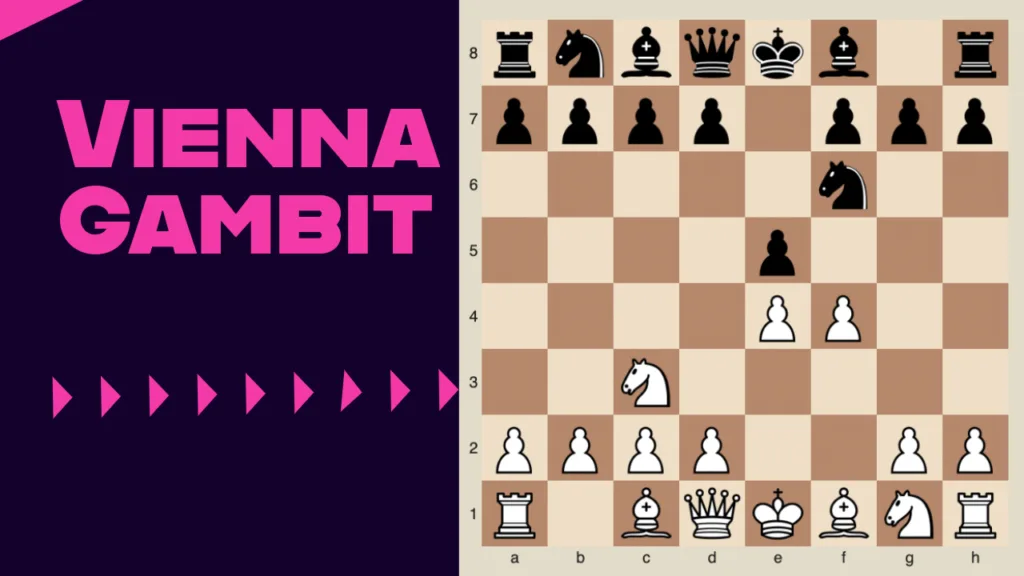In the deep forest of 1.e4 e5 openings, the Vienna Gambit is a trail less trodden, but one that crackles with tactical possibilities. Built on the move order 1.e4 e5 2.Nc3 followed by 3.f4, the Vienna Gambit is a relic of Romantic-era chess that has aged like a hidden vintage wine, sharp, underrated, and ready to surprise opponents from club level to online blitz arenas.
This is not just another King’s Gambit. It’s more refined, more flexible, and far more venomous than its reputation suggests.
What Is the Vienna Gambit?
The Vienna Gambit arises after:
- e4 e5
- Nc3 Nf6
- f4
The idea is simple: White delays Nf3 to prioritize immediate central pressure with f4. At first glance, it looks like just another gambit, but it’s not so easy to accept, and it’s incredibly dangerous to mishandle, especially if you’re on the Black side and not prepared.
Whereas the broader Vienna Game includes all continuations after 2.Nc3, the Vienna Gambit is laser-focused on aggression. It’s a razor aimed directly at the heart of Black’s early setup.
Why Choose the Vienna Gambit?
It’s Surprising, Even to Strong Players
As GothamChess (IM Levy Rozman) points out, “it’s pretty rare in a game of chess to be able to surprise your opponent as early as the second move.” That’s exactly what 2.Nc3 and 3.f4 can do. While most 1.e4 e5 games head toward the Ruy Lopez or Italian, the Vienna Gambit throws a wrench into the well-oiled machinery of classical play.
Even seasoned players can find themselves out of book early.
It’s Versatile: Pick Your Poison
This is not a one-line wonder. The Vienna Gambit offers multiple sub-variations to suit different styles. Positional players may gravitate toward the Modern Variation with 5.Nf3, while tactical fighters may love the wild complications of the Paulsen Attack with 5.Qf3 or even the Hamppe–Muzio Gambit, where White sacs a knight for blistering activity.
The Fork in the Road: How Black Responds to 3.f4
After 1.e4 e5 2.Nc3 Nf6 3.f4, Black has three main replies:
3…d5 – The Best and Boldest
This is the main line and best practical response. Black hits back in the center with immediate counterplay.
- 4.fxe5 Nxe4 Here White has three viable continuations, each leading to different types of battles:
- 5.Nf3 – The Modern Variation. Solid, flexible, and aiming to develop naturally.
- 5.d3 – Known as the Oxford Variation. A slower, positional response that puts pressure on the knight and keeps things under control.
- 5.Qf3 – The Paulsen Attack. A sharp and direct response that pressures e4 and often leads to tactical fireworks. It’s the most common choice (See below).
If Black goes for the logical moves next, White will have a big advantage, with 5… Nxc3 6. bxc3 Nc6 7. d4 +=
Each of these approaches has been extensively re-evaluated in recent years, especially with engine assistance. Many lines that were previously deemed “unclear” or even “bad” for White are now considered fully viable or better.
3…exf4 – Tempting, but Dangerous
Many club-level players reflexively grab the pawn. That’s good news for Vienna Gambiteers. Here come the Hamppe–Muzio Gambit:
- 3…exf4 4.Nf3 g5 5.Bc4 g4 6.0-0 gxf3 7.Qxf3!
White sacrifices a full knight for rapid development and an open, super dangerous f-file. Though not recommended for every occasion, it’s a killer weapon in blitz or against unprepared opponents. That’s why White has 60% chance of winning in this position, even though the eval bar says Black is much better.
3…d6 or 3…Nc6 – Passive or Punishable
Declining the gambit passively often leads to trouble.
- 3…d6 gives White free rein in the center after 4.Nf3 Nc6 5.Bb5 and 6.d3.
- 3…Nc6?! runs into 4.fxe5 Nxe5 5.d4! and suddenly White has a monster center.
As Levy notes, “if Black plays 3…Nc6, Black is essentially losing already.”
Traps, Tricks, and Tactical Chaos
One of the strongest arguments for the Vienna Gambit is how easy it is to punish inaccurate defense. Here are some highlights:
The Queen h4+ Trap
If White isn’t careful, …Qh4+ somewhere can lead to disaster. But if you’re ready for it:
- Play g3
- After …fxg3, go Nf3, hitting the queen
- If the queen steps back, play Nxd5, threatening Nc7+
However, in blitz game, it’s not that dangerous to allow Black to play Qh4+. Check out this game where Ivanchuk crushed Peter Svidler using the Vienna Gambit:
Even a queen sacrifice is on the table in some lines, with mating threats raining down.
The Forgotten Value of the Vienna Gambit
A book on the Vienna Gambit by Senior International Master Mike Read describes it as “a sound but relatively forgotten opening.” His analysis, built on modern engine lines, challenges decades of outdated theory. Many positions once dismissed are now shown to be entirely playable, even advantageous.
Some key takeaways from that work:
- Black often flounders as early as move 3.
- Variations once thought inferior (like 4.exd5) are actually viable.
- The Vienna Gambit offers four distinct paths for White depending on style: 5.Nf3, 5.Qf3, 5.d3, or 5.exd5.
It’s not just about sharp tactics, it’s about choice and adaptability.
Modern-Day Examples and Relevance
Though rare at the top level today, the Vienna Gambit has scored notable wins in online blitz and rapid formats, where preparation and time pressure are key.
Grandmasters may shy away from it in classical time controls, but online? It’s a wrecking ball. Even IMs and FMs struggle when caught off guard by the raw aggression and tactical landmines of the Vienna.
As GothamChess says, “You will get a lot of positions where they decline the gambit… but as long as you bring your bishop out, play d3, and castle, you’ll be more than okay.”
Conclusion: Should You Add the Vienna Gambit to Your Repertoire?
If you’re looking for:
- A way to surprise opponents in e4 e5 games
- A system with flexibility, from positional to explosive
- A chance to punish inaccuracies immediately
- Something off the beaten path yet objectively sound
Then yes, the Vienna Gambit is for you.
It’s time to dust off this underrated gem. Whether you’re a club player looking to win fast or a content creator hunting spicy games, the Vienna Gambit offers you one thing every chess player craves:
The initiative.
Let the fireworks begin.

I’m Xuan Binh, the founder of Attacking Chess, and the Deputy Head of Communications at the Vietnam Chess Federation (VCF). My chess.com and lichess rating is above 2300. Send me a challenge or message via Lichess. Follow me on Twitter (X) or Facebook.

